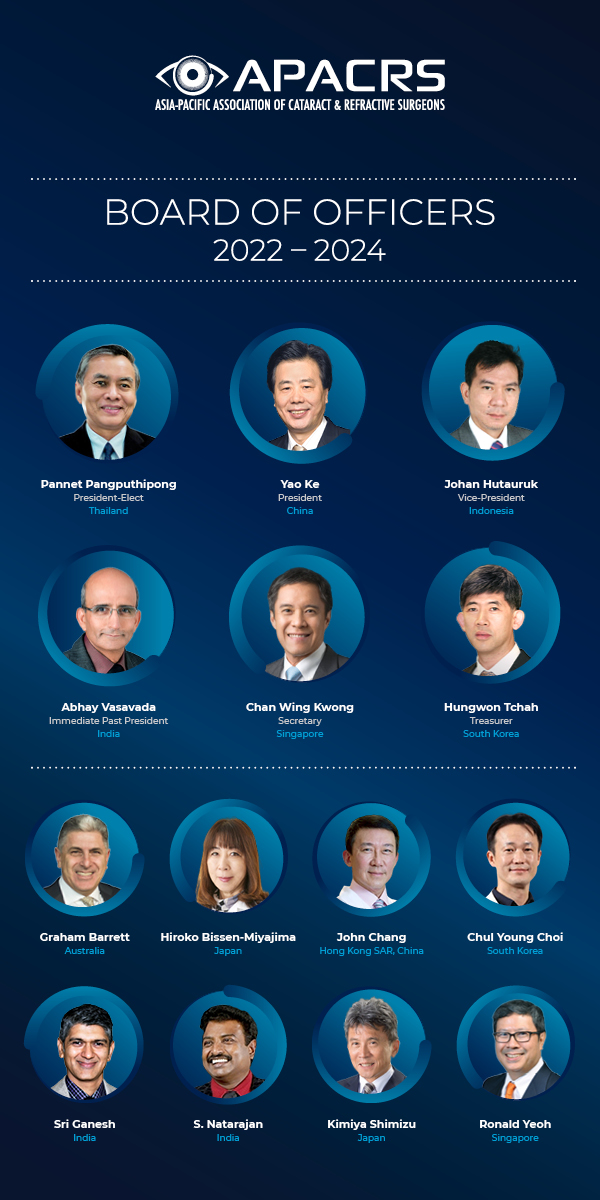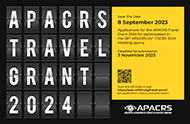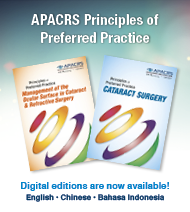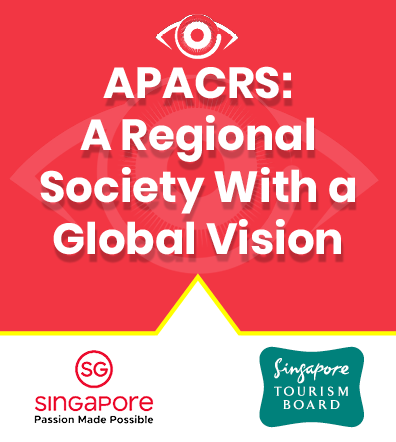Eyeworld Weekly Update |
Volume 19, Number 38 |
7 November 2014 |
- Visian ICL with CentraFLOW granted Chinese approval
- CMS grants ASC designation to IMT
- First-in-class RP drug granted orphan status
- First European patient implanted with STARflo
- Col-Treg achieves positive results in autoimmune uveitis
- U.S. DoD grants US$1.25M for whole-eye transplantation study
- ScienceBased Health appoints board members
- Imprimis Pharma inks distribution deal in PR
Visian ICL with CentraFLOW granted Chinese approval
The Visian ICL with CentraFLOW (STAAR Surgical, Monrovia, Calif., U.S.) has been granted regulatory approval from Chinese authorities, the company said. The implantable lens uses a proprietary port in the center of the ICL optic to "optimize the flow of fluid within the eye without affecting the quality of vision," according to STAAR. The CentraFLOW technology eliminates the need for surgeons to perform a YAG peripheral iridotomy procedure days before the ICL implant.CMS grants ASC designation to IMT
The Centers for Medicare and Medicaid Services will reimburse the Implantable Miniature Telescope (IMT) under a revised Ambulatory Payment Classification designation, APC 0351, Level V Intraocular Procedures, developer VisionCare Ophthalmic Technologies (Saratoga, Calif., U.S.) said in a news release. The new code goes into effect 1 Jan. 2015. The surgical procedure was previously restricted only to hospitals.The IMT is indicated for monocular implantation to improve vision in patients at least 65 years of age with stable severe to profound vision impairment (best corrected distance visual acuity 20/160 to 20/800) caused by bilateral central scotomas associated with end-stage age-related macular degeneration.
First-in-class RP drug granted orphan status
RST-001, a first-in-class gene therapy application of optogenetics designed to restore vision to those affected by retinitis pigmentosa (RP), has been granted orphan drug status by the U.S. Food and Drug Administration, said developer RetroSense Therapeutics (Ann Arbor, Mich., U.S.).According to the company, optogenetics refers broadly to means of conferring light sensitivity to cells that were not previously or natively light sensitive. By applying optogenetics to retinas in which rod and cone photoreceptors have degenerated, RetroSense is conferring new light sensitivity to the retina, with the expectation of improved or restored vision. RST-001 is expected to have application to all forms of RP, independent of causative gene or mutation, RetroSense added.
First European patient implanted with STARflo
The first patient in a European multicenter clinical trial has been successfully implanted with the STARflo glaucoma drainage device, developer iSTAR Medical (Isnes, Belgium) said in a news release. The study is designed to evaluate the efficacy and safety of the system in patients with open-angle glaucoma. The device received the CE mark in 2012.STARflo is a non-degradable, precision-pore implant made from the company's proprietary material. It is designed to operate as a bleb-free, micro-porous drainage system that augments the uveoscleral outflow.
Col-Treg achieves positive results in autoimmune uveitis
Col-Treg, a personalized T cell immunotherapy based on the regulatory properties of autologous collagen-II specific regulatory T lymphocytes, has shown positive early results, developer TxCell (Valbonne, France) said in a news release. Both pharmacodynamics and pharmacokinetic data showed a reduction in the severity of uveitis on clinical and histologic measures.Col-Treg is specifically designed to exert a multi-target, multi-mechanism suppressive and anti-inflammatory action locally in the eye upon recognition of collagen-II, a protein present in the vitreous body of both the eye and retina, the company said.
U.S. DoD grants US$1.25M for whole-eye transplantation study
The University of Pittsburgh (Pittsburgh, Penn., U.S.), Harvard University (Boston, Mass., U.S.), and the University of California, San Diego, will share a US$1.25 million grant from the U.S. Department of Defense (DoD) to fund 2 projects that aim to "establish the groundwork for the nation's first whole-eye transplantation program," according to a press release.The Audacious Restorative Goals in Ocular Sciences (ARGOS) Consortium established at Pitt will be the first cross-disciplinary, systematic attempt to explore strategies to enable corneal regeneration, retinal cell survival, long-distance optic nerve regeneration with cortical integration and whole-eyeball transplantation, the university said.
ScienceBased Health appoints board members
Houston, Texas-based ScienceBased Health has appointed Ike K. Ahmed, MD, and Lisa C. Olmos, MD, to its scientific advisory board, the company announced. ScienceBased Health is a provider of "premium nutraceuticals for eye health," and Dr. Ahmed said nutraceuticals "play an important role in the prevention and treatment of eye disease."Imprimis Pharma inks distribution deal in PR
Imprimis Pharmaceuticals (San Diego, Calif., U.S.) has granted MD Distributor Corp (Puerto Rico) the rights to market, sell, and distribute Imprimis' patent-pending Go Dropless formulations and other ophthalmic formulations in Puerto Rico. In addition, the agreement covers the Dominican Republic and countries in the Caribbean once regulatory approvals are obtained, Imprimis said.
RESEARCH BRIEFS
- S. Golan and colleagues compared the intraocular pressure (IOP)-lowering effect and safety profile of latanoprost (Xalatan, Pfizer, New York, NY, U.S.) with its generic variant, Glautan (Unipharm, Israel). They enrolled 19 patients (mean age at initial diagnosis 66±9 years, 14 females), of whom 17 had bilateral open-angle glaucoma and 2 had unilateral disease, who were already being seen for treatment between May 2010 and November 2012. After a 3-week washout period for the medicated subjects, the participants were randomized to 4 weeks of treatment with either Xalatan or Glautan once every evening and then, after a 3-week washout period, crossed over to the other treatment for an additional 4 weeks. Efficacy was expressed by change in IOP at 3 designated hours of the day after 1 week and 1 month of treatment, and tolerability was determined by ocular side effects as reported by the patient in a questionnaire. Both drugs lowered IOP after 1 week and 1 month of treatment. Xalatan had a tendency of greater efficacy than Glautan both after 1 week and 1 month, but the difference was not statistically significant (P=0.69 and P=0.34, respectively). Drug safety was similar, but more ocular side effects were reported after treatment with Glautan (21 vs. 12 for Xalatan, P=0.06). The study is published in Clinical and Experimental Pharmacology and Physiology.
- Larger lens vault, larger iris area, and smaller posterior corneal arch distance contribute considerably to anterior chamber angle narrowing after mydriasis in patients with cataract, according to S. Arimura and colleagues. In their interventional study, anterior chamber angle analysis was performed with anterior segment optical coherence tomography (AS-OCT) in patients with cataract before pharmacological pupillary dilation and 30 minutes afterward. Angle narrowing was quantified by the change of angle opening distance 500 after mydriasis (AOD500). A total of 102 Japanese patients (mean age 71.9 years) were enrolled; multivariate analysis indicated that smaller change of AOD500 were significantly associated with larger lens vault (P<0.001), larger iris area (P=0.003), and posterior corneal arch distance (P=0.01). These 3 factors explained 37.7% of the decrease in change of AOD500. The study is published in Graefe's Archives for Clinical and Experimental Ophthalmology.
- Toxic anterior segment syndrome (TASS) is preventable, but recognizing it, differentiating it from endophthalmitis, and starting treatment immediately is important, according to S. Cetinkaya and colleagues, who reported on a case series of 5/10 patients who developed TASS after being operated on during a single day by a single surgeon. On postop day 1, all five patients complained of blurred vision, but not pain. They had different degrees of diffuse corneal edema, anterior chamber reaction, fibrin, hypopyon, iris atrophies, and dilated pupils. Their vision decreased significantly, and their intraocular pressures increased. Both anti-inflammatory and anti-glaucomatous therapies were commenced. Corneal edema and inflammation resolved in 3 cases; however, penetrating keratoplasty was needed for two cases and additional trabeculectomy was needed for one case. Although full investigations were undertaken at all steps, the group could not find the causative agent. The study is published in Clinical Ophthalmology.
 Licensed Publications |
Licensed through ASCRS American Society of Cataract and Refractive Surgery, 4000 Legato Road, Suite 700, Fairfax, VA 22033-4003, USA.
All rights reserved. The ideas and opinions expressed in EyeWorld Asia-Pacific Weekly News do not necessarily reflect those of the ASCRS�ASOA or APACRS. Mention of products or services does not constitute an endorsement by the ASCRS�ASOA or APACRS. Copyright 2008, EyeWorld News Service, a division of ASCRS Media. |




 EyeSustain Update
EyeSustain Update 2024 APACRS TRAVEL GRANT
2024 APACRS TRAVEL GRANT Digital EyeWorld
Digital EyeWorld VOL. 39 (2023), ISSUE 3
VOL. 39 (2023), ISSUE 3  Membership Information
Membership Information APACRS Principles of Preferred Practice
APACRS Principles of Preferred Practice